This morning we awoke to partly cloudy skies, but no rain. We had to bail a ton of water out of the dinghy and there were big pools of water in the street, which we took as a bad sign for the long road to be open. We hopped in the jeep and headed back up to the Washington-Slagbaai park.
This time we took the coastal road up. When we had gone to the camera store on the edge of town the other day, for some reason we thought there wasn’t much development beyond that point. We turned out to be wrong. Just around a bend in the road, out of the line of sight from where we were standing that day, is where the high rent district begins. There are some posh homes up there. The homes on our left are on the water, and on our right, the homes are on a hill with great ocean views. Many look brand new and many more are under construction.
Eventually the houses faded and it was back to undeveloped land. The views are beautiful, and once again, we saw many trucks pulled over to the side of the road indicating divers in the water. The road beyond the residential area is really only wide enough for one car. While some of this road is one way, most of it allows two way traffic. We can’t see how two cars can squeeze on this little road. At the turnoff, we headed inland, past Rincon and on up to the park entrance. It was no surprise that the long road was closed, so we contented ourselves to the short road. Right off the bat, it was clear it was going to be a bumpy ride.
Washington-Slagbaai is a 5643 hectare nature sanctuary that encompasses the entire northwest tip of the island. The land used to be two plantations, Washington and Slaagbai, which is where the name came from. Several endangered species live there. One is the yellow shouldered Amazon parrot, which has small numbers in the wild today because humans keep capturing them to use as pets since they “talk”. The northern beaches are a nesting ground for all four species of sea turtles found in the Caribbean. In addition to the endangered wildlife, there are 9 species of lizards, and two of them are found only on Bonaire and nowhere else in the world. There are 8 types of bats, three of them herbivores. The herbivores are key to the local environment because they cross pollinate plants, especially the cactus. There are several other types of birds found in the park, as well.
The landscape up here is much the same as we described on the way up yesterday, but it has even more cactus.

We passed by Salina Matijs, which is a large pond where flamingos happily grazed in the distance. Of course, they were so far away they looked like dots. We passed a couple more small ponds near Salina Matijs with more barely visible flamingos. Past the ponds, it was acres and acres of undeveloped land. Zillions of lizards of all sorts were along the road, and at one point a big, fat iguana was parked in the center of the road and we had to wait for it to move. We also saw two bright green parrots flying over the road that were really neat to see. They vanished in the thick brush.
We came to a hiking trail called Brandaris and parked. It is a hike to a viewpoint 784 feet up that is listed as one of the park’s highlights. We started walking up the trail. We saw either a large goat or a small deer run across the path. It started to drizzle, so we turned around, not wanting to get caught in the large downpour that usually quickly follows such drizzles. It never did turn to real rain.
We continued driving until we got to the shore. We stopped at a place called Playa Funchi, a narrow strip of land with ocean on one side and a large pond with flamingos on the other side. It is a pretty viewpoint. It is also a dive site, and we watched some divers getting ready to go in. These pictures are meant to be laid side by side for a panoramic view.
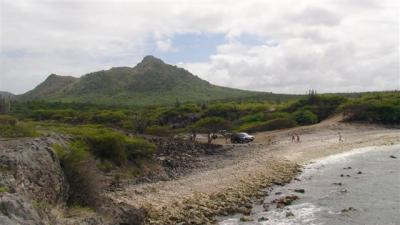
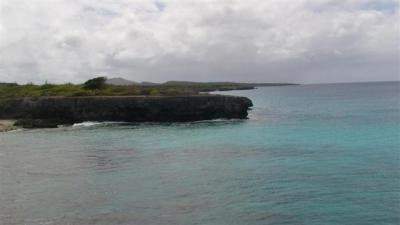
We went on to the next viewpoint along the water, where we bumped into our neighbors On Nereia. They were with the couple on the other side of them, who we hadn’t met yet. Of course, we stopped and chatted with them for a while. One shot is facing the ocean, the other is facing inland.
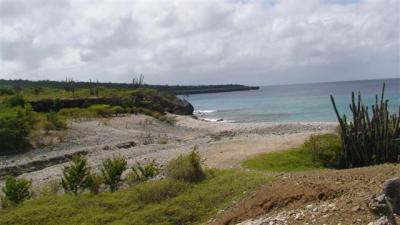

They were feeding the lizards and there were zillions of them running at our feet. A few even got daring and touched our feet. These are shots of the two more dominant species. We think the blue ones are really cool looking.
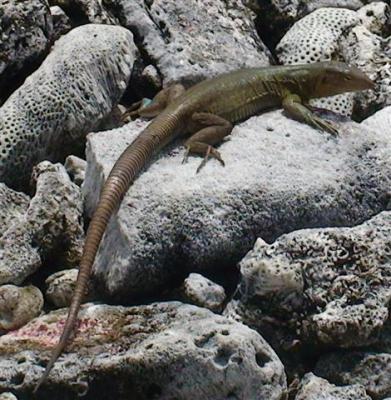
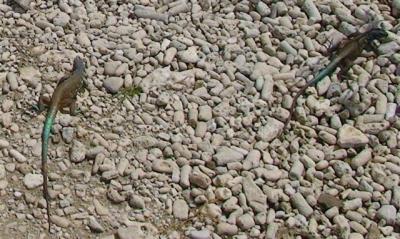
Then we stopped at a restaurant run by the park service. It is built on a small swath of land between the sea and a salt pond. This pond had three flamingos in the water right near the restaurant, so we finally got a really good close up view of wild flamingos. We watched them for quite a while. They are fascinating creatures — very elegant.
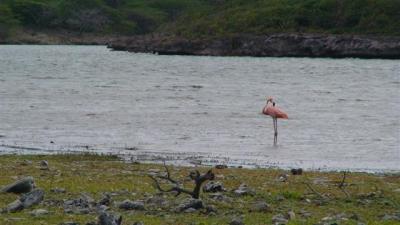
We got back on the dirt road and followed it back to the visitor center. There weren’t really any places to stop between the restaurant and the visitor’s center. In here there were quite a few animals. Most of them we only got fleeting glances of, but we did get a good look at a mule, a huge boar, and a goat or sheep. As we drove, we talked about how hard it must have been to cut the road through the park interior because the vegetation is really thick, and most of it is thorny. And for that matter, it can’t be easy to maintain the road. The bushes probably have to be constantly pruned and the ruts constantly repaired. There are a lot of very large puddles in the road and we know every car that drives through them probably damages the road more. You definitely need a vehicle with good suspension on this road. We see why they recommend a 4 wheel drive. There were a few spots we used it, and it was fun to be four wheeling.
When we made it back to the visitor’s center, we stopped to look around. We mentioned there were several buildings. There is a ticket booth, gift shop, library and a museum. We headed into the museum. It is another one of those very small, but very informative sorts. There was a section on life during the plantation days, a section on science, including geology and different types of rocks, and a section on different species of flora and fauna found in the park. There was also a Bonaire history timeline.
After we finished at the museum, we headed to”¦ to be continued”¦

Ok guys, your back & those of us looking forward to this dream you just accomplished are asking:
In your experience, what should we budget as a monthly cost for boat maintenance. I get that each place has different fuel, food, and other cost, but those are semi controllable (ie dont stop there).
You guys have been there and done that, what’s the real cost. Did you stay in budget, or go way over. Was it cheaper than you planned for?
Again,
Welcome back